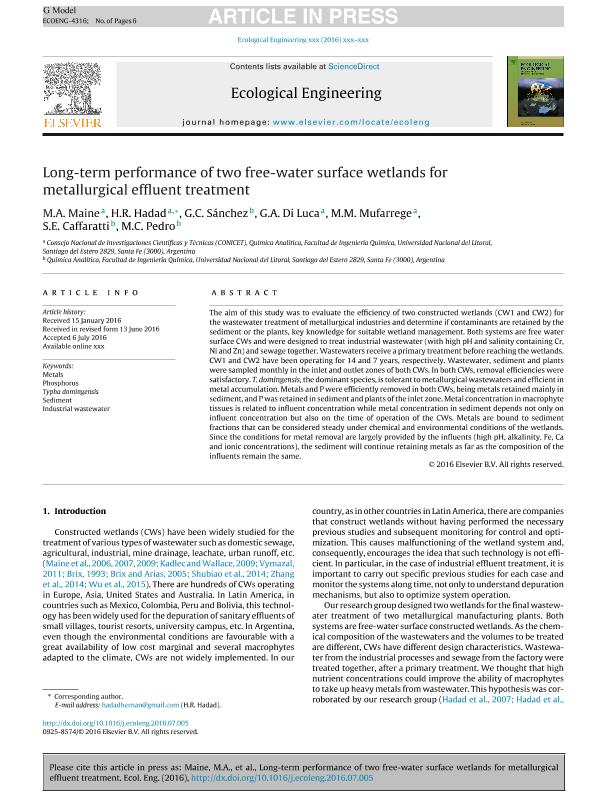Mostrar el registro sencillo del ítem
dc.contributor.author
Maine, Maria Alejandra

dc.contributor.author
Hadad, Hernán Ricardo

dc.contributor.author
Sanchez, Gabriela Cristina

dc.contributor.author
Di Luca, Gisela Alfonsina

dc.contributor.author
Mufarrege, María de Las Mercedes

dc.contributor.author
Caffaratti, Sandra Ester

dc.contributor.author
Pedro, María del Carmen

dc.date.available
2019-02-01T15:15:30Z
dc.date.issued
2017-01
dc.identifier.citation
Maine, Maria Alejandra; Hadad, Hernán Ricardo; Sanchez, Gabriela Cristina; Di Luca, Gisela Alfonsina; Mufarrege, María de Las Mercedes; et al.; Long-term performance of two free-water surface wetlands for metallurgical effluent treatment; Elsevier Science; Ecological Engineering; 98; 1-2017; 372-377
dc.identifier.issn
0925-8574
dc.identifier.uri
http://hdl.handle.net/11336/69178
dc.description.abstract
The aim of this study was to evaluate the efficiency of two constructed wetlands (CW1 and CW2) for the wastewater treatment of metallurgical industries and determine if contaminants are retained by the sediment or the plants, key knowledge for suitable wetland management. Both systems are free water surface CWs and were designed to treat industrial wastewater (with high pH and salinity containing Cr, Ni and Zn) and sewage together. Wastewaters receive a primary treatment before reaching the wetlands. CW1 and CW2 have been operating for 14 and 7 years, respectively. Wastewater, sediment and plants were sampled monthly in the inlet and outlet zones of both CWs. In both CWs, removal efficiencies were satisfactory. T. domingensis, the dominant species, is tolerant to metallurgical wastewaters and efficient in metal accumulation. Metals and P were efficiently removed in both CWs, being metals retained mainly in sediment, and P was retained in sediment and plants of the inlet zone. Metal concentration in macrophyte tissues is related to influent concentration while metal concentration in sediment depends not only on influent concentration but also on the time of operation of the CWs. Metals are bound to sediment fractions that can be considered steady under chemical and environmental conditions of the wetlands. Since the conditions for metal removal are largely provided by the influents (high pH, alkalinity, Fe, Ca and ionic concentrations), the sediment will continue retaining metals as far as the composition of the influents remain the same.
dc.format
application/pdf
dc.language.iso
eng
dc.publisher
Elsevier Science

dc.rights
info:eu-repo/semantics/openAccess
dc.rights.uri
https://creativecommons.org/licenses/by-nc-sa/2.5/ar/
dc.subject
Industrial Wastewater
dc.subject
Metals
dc.subject
Phosphorus
dc.subject
Sediment
dc.subject
Typha Domingensis
dc.subject.classification
Meteorología y Ciencias Atmosféricas

dc.subject.classification
Ciencias de la Tierra y relacionadas con el Medio Ambiente

dc.subject.classification
CIENCIAS NATURALES Y EXACTAS

dc.title
Long-term performance of two free-water surface wetlands for metallurgical effluent treatment
dc.type
info:eu-repo/semantics/article
dc.type
info:ar-repo/semantics/artículo
dc.type
info:eu-repo/semantics/publishedVersion
dc.date.updated
2019-01-22T18:51:30Z
dc.journal.volume
98
dc.journal.pagination
372-377
dc.journal.pais
Países Bajos

dc.journal.ciudad
Amsterdam
dc.description.fil
Fil: Maine, Maria Alejandra. Universidad Nacional del Litoral. Facultad de Ingeniería Química. Laboratorio de Química Analítica; Argentina. Consejo Nacional de Investigaciones Científicas y Técnicas. Centro Científico Tecnológico Conicet - Santa Fe; Argentina
dc.description.fil
Fil: Hadad, Hernán Ricardo. Universidad Nacional del Litoral. Facultad de Ingeniería Química. Laboratorio de Química Analítica; Argentina. Consejo Nacional de Investigaciones Científicas y Técnicas. Centro Científico Tecnológico Conicet - Santa Fe; Argentina
dc.description.fil
Fil: Sanchez, Gabriela Cristina. Universidad Nacional del Litoral. Facultad de Ingeniería Química. Laboratorio de Química Analítica; Argentina
dc.description.fil
Fil: Di Luca, Gisela Alfonsina. Universidad Nacional del Litoral. Facultad de Ingeniería Química. Laboratorio de Química Analítica; Argentina. Consejo Nacional de Investigaciones Científicas y Técnicas. Centro Científico Tecnológico Conicet - Santa Fe; Argentina
dc.description.fil
Fil: Mufarrege, María de Las Mercedes. Universidad Nacional del Litoral. Facultad de Ingeniería Química. Laboratorio de Química Analítica; Argentina. Consejo Nacional de Investigaciones Científicas y Técnicas. Centro Científico Tecnológico Conicet - Santa Fe; Argentina
dc.description.fil
Fil: Caffaratti, Sandra Ester. Universidad Nacional del Litoral. Facultad de Ingeniería Química. Laboratorio de Química Analítica; Argentina
dc.description.fil
Fil: Pedro, María del Carmen. Universidad Nacional del Litoral. Facultad de Ingeniería Química. Laboratorio de Química Analítica; Argentina
dc.journal.title
Ecological Engineering

dc.relation.alternativeid
info:eu-repo/semantics/altIdentifier/doi/https://doi.org/10.1016/j.ecoleng.2016.07.005
dc.relation.alternativeid
info:eu-repo/semantics/altIdentifier/url/https://www.sciencedirect.com/science/article/pii/S0925857416304566
Archivos asociados
